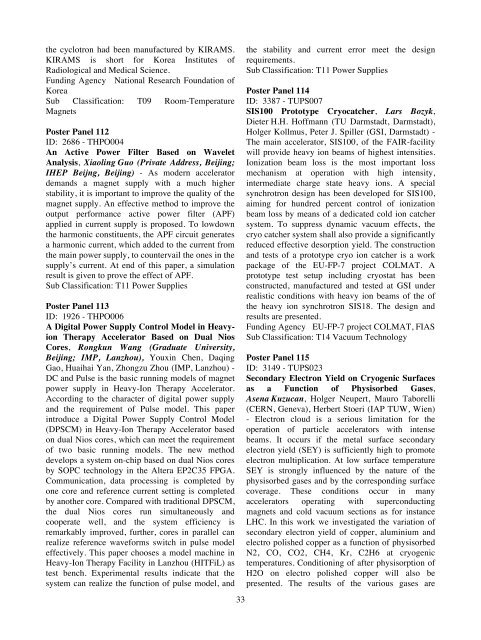Abstracts Brochure - 2nd International Particle Accelerator Conference
Abstracts Brochure - 2nd International Particle Accelerator Conference
Abstracts Brochure - 2nd International Particle Accelerator Conference
You also want an ePaper? Increase the reach of your titles
YUMPU automatically turns print PDFs into web optimized ePapers that Google loves.
the cyclotron had been manufactured by KIRAMS.<br />
KIRAMS is short for Korea Institutes of<br />
Radiological and Medical Science.<br />
Funding Agency National Research Foundation of<br />
Korea<br />
Sub Classification: T09 Room-Temperature<br />
Magnets<br />
Poster Panel 112<br />
ID: 2686 - THPO004<br />
An Active Power Filter Based on Wavelet<br />
Analysis, Xiaoling Guo (Private Address, Beijing;<br />
IHEP Beijng, Beijing) - As modern accelerator<br />
demands a magnet supply with a much higher<br />
stability, it is important to improve the quality of the<br />
magnet supply. An effective method to improve the<br />
output performance active power filter (APF)<br />
applied in current supply is proposed. To lowdown<br />
the harmonic constituents, the APF circuit generates<br />
a harmonic current, which added to the current from<br />
the main power supply, to countervail the ones in the<br />
supply’s current. At end of this paper, a simulation<br />
result is given to prove the effect of APF.<br />
Sub Classification: T11 Power Supplies<br />
Poster Panel 113<br />
ID: 1926 - THPO006<br />
A Digital Power Supply Control Model in Heavyion<br />
Therapy <strong>Accelerator</strong> Based on Dual Nios<br />
Cores, Rongkun Wang (Graduate University,<br />
Beijing; IMP, Lanzhou), Youxin Chen, Daqing<br />
Gao, Huaihai Yan, Zhongzu Zhou (IMP, Lanzhou) -<br />
DC and Pulse is the basic running models of magnet<br />
power supply in Heavy-Ion Therapy <strong>Accelerator</strong>.<br />
According to the character of digital power supply<br />
and the requirement of Pulse model. This paper<br />
introduce a Digital Power Supply Control Model<br />
(DPSCM) in Heavy-Ion Therapy <strong>Accelerator</strong> based<br />
on dual Nios cores, which can meet the requirement<br />
of two basic running models. The new method<br />
develops a system on-chip based on dual Nios cores<br />
by SOPC technology in the Altera EP2C35 FPGA.<br />
Communication, data processing is completed by<br />
one core and reference current setting is completed<br />
by another core. Compared with traditional DPSCM,<br />
the dual Nios cores run simultaneously and<br />
cooperate well, and the system efficiency is<br />
remarkably improved, further, cores in parallel can<br />
realize reference waveforms switch in pulse model<br />
effectively. This paper chooses a model machine in<br />
Heavy-Ion Therapy Facility in Lanzhou (HITFiL) as<br />
test bench. Experimental results indicate that the<br />
system can realize the function of pulse model, and<br />
�<br />
33<br />
the stability and current error meet the design<br />
requirements.<br />
Sub Classification: T11 Power Supplies<br />
Poster Panel 114<br />
ID: 3387 - TUPS007<br />
SIS100 Prototype Cryocatcher, Lars Bozyk,<br />
Dieter H.H. Hoffmann (TU Darmstadt, Darmstadt),<br />
Holger Kollmus, Peter J. Spiller (GSI, Darmstadt) -<br />
The main accelerator, SIS100, of the FAIR-facility<br />
will provide heavy ion beams of highest intensities.<br />
Ionization beam loss is the most important loss<br />
mechanism at operation with high intensity,<br />
intermediate charge state heavy ions. A special<br />
synchrotron design has been developed for SIS100,<br />
aiming for hundred percent control of ionization<br />
beam loss by means of a dedicated cold ion catcher<br />
system. To suppress dynamic vacuum effects, the<br />
cryo catcher system shall also provide a significantly<br />
reduced effective desorption yield. The construction<br />
and tests of a prototype cryo ion catcher is a work<br />
package of the EU-FP-7 project COLMAT. A<br />
prototype test setup including cryostat has been<br />
constructed, manufactured and tested at GSI under<br />
realistic conditions with heavy ion beams of the of<br />
the heavy ion synchrotron SIS18. The design and<br />
results are presented.<br />
Funding Agency EU-FP-7 project COLMAT, FIAS<br />
Sub Classification: T14 Vacuum Technology<br />
Poster Panel 115<br />
ID: 3149 - TUPS023<br />
Secondary Electron Yield on Cryogenic Surfaces<br />
as a Function of Physisorbed Gases,<br />
Asena Kuzucan, Holger Neupert, Mauro Taborelli<br />
(CERN, Geneva), Herbert Stoeri (IAP TUW, Wien)<br />
- Electron cloud is a serious limitation for the<br />
operation of particle accelerators with intense<br />
beams. It occurs if the metal surface secondary<br />
electron yield (SEY) is sufficiently high to promote<br />
electron multiplication. At low surface temperature<br />
SEY is strongly influenced by the nature of the<br />
physisorbed gases and by the corresponding surface<br />
coverage. These conditions occur in many<br />
accelerators operating with superconducting<br />
magnets and cold vacuum sections as for instance<br />
LHC. In this work we investigated the variation of<br />
secondary electron yield of copper, aluminium and<br />
electro polished copper as a function of physisorbed<br />
N2, CO, CO2, CH4, Kr, C2H6 at cryogenic<br />
temperatures. Conditioning of after physisorption of<br />
H2O on electro polished copper will also be<br />
presented. The results of the various gases are


